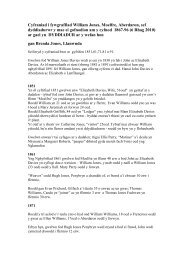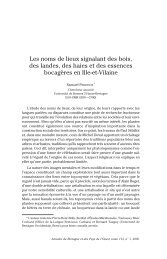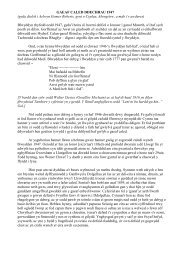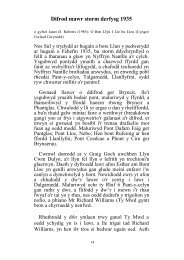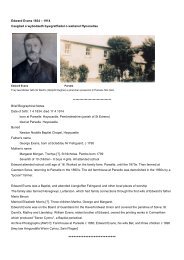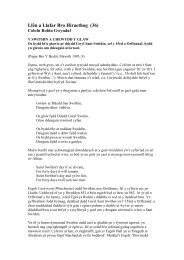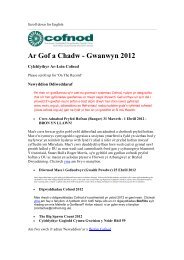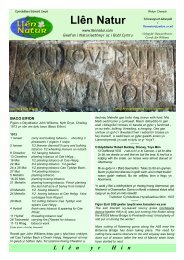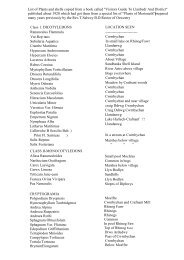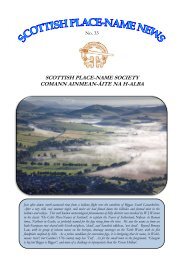Llanilar. — The church was dedicated to St. Hilary, who flourished <strong>in</strong> <strong>the</strong> sixth century; but one writer derivesliar from ill, a particle imply<strong>in</strong>g two, both, <strong>and</strong> double, <strong>and</strong> dr, l<strong>and</strong>; hence <strong>the</strong> name signifies two portions <strong>of</strong>l<strong>and</strong>, or territories. The parish conta<strong>in</strong>s two hamlets bear<strong>in</strong>g <strong>the</strong> <strong>names</strong> Llanilar Uchaf (higher) <strong>and</strong> LlanilarIsaf (lower). English name — Hilarton.Llan<strong>in</strong>a. — The church was dedicated to Ina, k<strong>in</strong>g <strong>of</strong> <strong>the</strong> West Saxons. English name — Inaton.Llanllwchhaiarn. — Llwchhaiarn was a sa<strong>in</strong>t <strong>of</strong> <strong>the</strong> seventh century. Iolo MSS. give him <strong>the</strong> honour <strong>of</strong>hav<strong>in</strong>g founded many churches, among which <strong>the</strong> above is named. English name — Ironton.Llanllyr. — Llyr Met<strong>in</strong>i flourished about <strong>the</strong> end <strong>of</strong> <strong>the</strong> fifth century, <strong>and</strong> founded a church <strong>and</strong> nunnery at <strong>the</strong>above <strong>place</strong>. English name — Lyrton.Llanrhystyd. — The church was dedicated to Rhystyd, a descendant <strong>of</strong> Hywel ap Emyr Llydaw, wh<strong>of</strong>lourished <strong>in</strong> <strong>the</strong> sixteenth century." Rhystyd Sant, rhyw astud serch,A roe lln ar ryw lanerch. "i.e. — St. Rhystyd, with <strong>the</strong> love <strong>of</strong> pious zeal, Would with a l<strong>in</strong>e enclose some sacred spot. English name —Rhystyd.Llansantffraid. — The common op<strong>in</strong>ion is that <strong>the</strong> church was dedicated to Sanffraid, but we are <strong>in</strong>cl<strong>in</strong>ed toth<strong>in</strong>k it was dedicated to St. Ffraid, who was called Bridget or Bride, a celebrated Irish sa<strong>in</strong>t. English name —Brideton.Llanwenog. — St. Gwenog is recorded to have founded <strong>the</strong> church. English name — Gwenogton.Llanwndws. — Wndws is a corruption <strong>of</strong> Gwynws, <strong>the</strong> name <strong>of</strong> <strong>the</strong> sa<strong>in</strong>t who founded <strong>the</strong> church <strong>in</strong> <strong>the</strong> sixthcentury. English name — Whitton.Llanwnen. — Wnen is a corruption <strong>of</strong> Gwnen, <strong>the</strong> name <strong>of</strong> <strong>the</strong> sa<strong>in</strong>t to whom it is supposed <strong>the</strong> church isdedicated. English name — Risby.Llechryd. — Llech, a stone; rhyd, a ford, a stream. This <strong>place</strong> is generally po<strong>in</strong>ted out as <strong>the</strong> scene <strong>of</strong> aterrible engagement that took <strong>place</strong> between Rhys ab Tewdwr <strong>and</strong> <strong>the</strong> three sons <strong>of</strong> Bleddyn ab Cynvyn, <strong>in</strong>1087, <strong>in</strong> which <strong>the</strong> sons <strong>of</strong> Bleddyn were defeated, <strong>and</strong> two <strong>of</strong> <strong>the</strong>m sla<strong>in</strong> on <strong>the</strong> field. In course <strong>of</strong> time it isthought a stone was raised here <strong>in</strong> memory <strong>of</strong> Riryd, one <strong>of</strong> Bleddyn's sons. Some th<strong>in</strong>k <strong>the</strong> name is derivedfrom <strong>the</strong> river be<strong>in</strong>g seamed with ledges <strong>of</strong> rock. English name — Stoneford.Llwyndafydd. — Llwyn, bush; Dafydd, David; from an ancient house <strong>in</strong> <strong>the</strong> <strong>place</strong>, which belonged to Dafyddab Ieuan, <strong>and</strong> where he enterta<strong>in</strong>ed <strong>the</strong> Earl <strong>of</strong> Richmond on his way to Bosworth field. English name —Davidston.Merthyr Cyflefyr. — Merthyr, martyr; Cyfiefyr, name <strong>of</strong> a descendant <strong>of</strong> Brychan, who is supposed to havebeen murdered at a <strong>place</strong> ever s<strong>in</strong>ce called after his name. English name — Martyrham.Mochros. — Moch, pigs; rhos, a meadow, a moor. Tradition says that St. Dyfrig was warned <strong>in</strong> this <strong>place</strong> byan angel to build a church <strong>in</strong> <strong>the</strong> name <strong>of</strong> <strong>the</strong> Tr<strong>in</strong>ity, where he would see a white sow ly<strong>in</strong>g with hersuckl<strong>in</strong>gs; hence <strong>the</strong> name. If we take mdch as an adjective, it means quick, abrupt. Therefore, <strong>the</strong> <strong>names</strong>ignifies a slop<strong>in</strong>g meadow. English name — Pigmoor.Mydyreil<strong>in</strong>. — The name, probably, means <strong>the</strong> eil<strong>in</strong> (arm) <strong>of</strong> <strong>the</strong> river Mudyr. Penel<strong>in</strong> is <strong>the</strong> Welsh for elbow.The crooked course <strong>of</strong> <strong>the</strong> river here rem<strong>in</strong>ds <strong>the</strong> observer very vividly <strong>of</strong> a man hold<strong>in</strong>g his arm <strong>in</strong> a sl<strong>in</strong>g.Myllyr is a corrupt form <strong>of</strong> Mudyr, <strong>the</strong> silent water. English name — Armton.Nantcwnlle. — Nant, brook; Cwnlle, a corruption <strong>of</strong> Cunllo, an em<strong>in</strong>ent British sa<strong>in</strong>t <strong>of</strong> <strong>the</strong> fifth century. Theparish is <strong>in</strong>tersected by <strong>the</strong> brook, <strong>and</strong> <strong>the</strong> church is dedicated to Cunllo. English name — Brookham.Nanteirw. — This <strong>place</strong> derives its name from <strong>the</strong> brook Eirw. Nant, brook; eirw, eirwy, a. foam<strong>in</strong>g cataract.Orig<strong>in</strong> <strong>of</strong> Place-<strong>names</strong> <strong>in</strong> Wales & Monmouthshire Page 29
Some th<strong>in</strong>k that eirw is a corruption <strong>of</strong> aeron, summer fruits, so called on account <strong>of</strong> <strong>the</strong> abundance <strong>of</strong> <strong>the</strong>sefruits on <strong>the</strong> banks <strong>of</strong> <strong>the</strong> rivulet. English name — Foam brook.Newchurch. — It was anciently called Llanfihangel- y-Creuddyn-Uchaf. The new name was derived from <strong>the</strong>fact that Colonel Thomas Johns, Hafod Uchtryd, built a new church here <strong>in</strong> 1803.Penddol. — Pen, top; dol, meadow, signify<strong>in</strong>g a <strong>place</strong> at <strong>the</strong> top or head <strong>of</strong> a meadow. English name —Upton.Penrhiwbal. — Pen, top rhiw, slope; bal, prom<strong>in</strong>ence. Bal is a general term applied to those mounta<strong>in</strong>s thatterm<strong>in</strong>ate <strong>in</strong> a peak. English name — Peakton.Penrhylog. — Pen, head, top; rhylog, accord<strong>in</strong>g to some, is a contraction <strong>of</strong> yr-haleg, salty <strong>place</strong>. We ra<strong>the</strong>rth<strong>in</strong>k it to be rhylleg, <strong>the</strong> name <strong>in</strong> full signify<strong>in</strong>g a high <strong>place</strong> full <strong>of</strong> clefts. English name — Clef<strong>the</strong>ad.Penrhyngoch. — Penrhyn, headl<strong>and</strong>; coch, red, so called from <strong>the</strong> hue <strong>of</strong> <strong>the</strong> soil <strong>of</strong> <strong>the</strong> l<strong>and</strong>. English name— Redl<strong>and</strong>.Pentref Talies<strong>in</strong>. — Pentref, a village; Talies<strong>in</strong>, <strong>the</strong> name <strong>of</strong> <strong>the</strong> chief <strong>of</strong> <strong>the</strong> Welsh bards. His sepulture took<strong>place</strong> near <strong>the</strong> village. English name — Bardham.Penybryn. — The name, which signifies " <strong>the</strong> head or top <strong>of</strong> <strong>the</strong> hill," is derived from <strong>the</strong> situation <strong>of</strong> <strong>the</strong>church on <strong>the</strong> summit <strong>of</strong> a hill overlook<strong>in</strong>g <strong>the</strong> sea. Sometimes <strong>the</strong> parish is called Llanfihangel Penybrynfrom <strong>the</strong> dedication <strong>of</strong> <strong>the</strong> church to St. Michael. English name — Hilltop.Penyparc. — Parc means an enclosed piece <strong>of</strong> l<strong>and</strong>. In <strong>the</strong> Sou<strong>the</strong>rn counties it is synonymous with cae, afield. Penyparc, <strong>the</strong>refore, means <strong>the</strong> end <strong>of</strong> a field. Park is an Anglicized form <strong>of</strong> pare, English name —Parksend.Ponterwyd. — Pont, bridge; Erwyd, <strong>the</strong> name <strong>of</strong> <strong>the</strong> river that flows under <strong>the</strong> bridge. The village derives itsname from <strong>the</strong> old bridge. English name — Bridgewater.Pontrhydfendigaid. — Bendigaid, blessed. This name, evidently, is a relic <strong>of</strong> <strong>the</strong> Roman epoch. Theblessed celebrities <strong>of</strong> <strong>the</strong> monastery at Strata Florida were wont to cross a certa<strong>in</strong> ford <strong>in</strong> <strong>the</strong> river, where<strong>the</strong>y <strong>in</strong>voked <strong>the</strong> bless<strong>in</strong>gs <strong>of</strong> <strong>the</strong> blessed virg<strong>in</strong>, over which, <strong>in</strong> course <strong>of</strong> time, a bridge was built ; hence <strong>the</strong>name. English name — Blissford.Pontrhydygroes. — Pont, bridge; rhyd, ford; y, <strong>the</strong>; groes, cross. English name — CrossfordRhiwar<strong>the</strong>n. — Rhiw, slope, declivity; Art hen, accord<strong>in</strong>g to some, is <strong>the</strong> name <strong>of</strong> a k<strong>in</strong>g or lord <strong>of</strong>Ceredigion, who died <strong>in</strong> 804, but we ra<strong>the</strong>r th<strong>in</strong>k it is a clipped form <strong>of</strong> gar<strong>the</strong>n, a camp or battle. Englishname — Camphill.Rhuddlan. — A compound <strong>of</strong> rhudd, red; <strong>and</strong> glan, bank. English name — Redbank.Rhydmanteg. — Rhyd, ford; man, <strong>place</strong>, spot; teg, fair. English name — Fordham.Rhyd-Pennant. — Pennant means <strong>the</strong> end <strong>of</strong> <strong>the</strong> brook. English name — Brookford.Sarnau. — This name is <strong>the</strong> plural form <strong>of</strong> sarn, paved road, causeway, so called from <strong>the</strong> rema<strong>in</strong>s <strong>of</strong>several paved roads across a bog <strong>in</strong> <strong>the</strong> district. English name — Roadby.Strata Florida. — Strata, paved roads. The Roman strata became <strong>the</strong> Saxon streets. Florida, abound<strong>in</strong>gwith flowers. Some ma<strong>in</strong>ta<strong>in</strong> that <strong>the</strong> abbey was dedicated to Fflur, <strong>the</strong> daughter <strong>of</strong> Mygnach Gorr, but <strong>the</strong>supposition is unsupported by historical fact. An eye-witness wrote, a few years ago, anent <strong>the</strong> famous <strong>place</strong>— " even now <strong>the</strong> adjacent peat l<strong>and</strong> is covered with heath flowers. As we were travell<strong>in</strong>g over it, reach<strong>in</strong>gTregaron about sunset, we gazed on <strong>the</strong> scene, <strong>and</strong> <strong>the</strong> whole extensive pla<strong>in</strong> blushed as it ba<strong>the</strong>d <strong>in</strong> a sea<strong>of</strong> purple. '" English name — Floridton.Swyddffynon. — Swydd here means jurisdiction. In ancient times <strong>the</strong> law court <strong>of</strong> <strong>the</strong> commot <strong>of</strong> Mefenyddwas held here, perhaps near a celebrated well, called Ffynon oer, cold well. English name — Lexwell.Orig<strong>in</strong> <strong>of</strong> Place-<strong>names</strong> <strong>in</strong> Wales & Monmouthshire Page 30
- Page 1 and 2: HANDBOOK OF THE ORIGIN OF PLACE-NAM
- Page 3 and 4: § § § § §The Author begs to st
- Page 5 and 6: pitiful cries of the railway offici
- Page 7 and 8: Bishop Percy says that "in England,
- Page 9 and 10: The city of Chester is still popula
- Page 11 and 12: There's Cumwhitton, Cumwhinton, Cum
- Page 13 and 14: Llwyn in its primary' sense means a
- Page 15 and 16: PLACE-NAMES IN WALES.Wales. — The
- Page 17 and 18: Church are generally dedicated to e
- Page 19 and 20: think he was a contemporary of St.
- Page 21 and 22: Rhosbeirio. — Rhos, a moor, a dry
- Page 23 and 24: of Brecknock," states that this vic
- Page 25 and 26: Cam cnwir ef Cwmdu,Cwm gwyn yw & n
- Page 27 and 28: Penderyn. — A corruption probably
- Page 29 and 30: Ardudwy. — Ar, upon or above; tud
- Page 31: to mark its pre-eminence over the o
- Page 35 and 36: present form — Caerfyrddin.Abergw
- Page 37 and 38: place of refuge; hence the name. En
- Page 39 and 40: Llansawyl. — The church was dedic
- Page 41 and 42: eject. The village took its name fr
- Page 43 and 44: house, and attempted to kill an inf
- Page 45 and 46: Gwydir. — Prima facie one may tak
- Page 47 and 48: Nefyn. — The church was probably
- Page 49 and 50: DENBIGHSHIRE.Anglicized form of Din
- Page 51 and 52: Llangollen. — From Collen, a sain
- Page 53 and 54: hands into their pockets to pay a c
- Page 55 and 56: Cefn. — The name signifies a ridg
- Page 57 and 58: Maesgarmon. — Named in honour of
- Page 59 and 60: Abertridwr. — Tridwr, three water
- Page 61 and 62: it is said, was originally built by
- Page 63 and 64: Cwmllynfell. — Cwm, a narrow vale
- Page 65 and 66: Gwarycaeau. — Gwdr, the nape of t
- Page 67 and 68: means a cultivated region, a vale,
- Page 69 and 70: Penrhiwfer.- Pen, head, top; rhiw,
- Page 71 and 72: Port Talbot. — So called in 1835
- Page 73 and 74: Trealaw. — This appellation was g
- Page 75 and 76: Aberdyfi. — So called from its si
- Page 77 and 78: Llanddwywe. — From Dwywau, a desc
- Page 79 and 80: Crickhowell and some in the directi
- Page 81 and 82: Griffithstown. — This village was
- Page 83 and 84:
and gwy, water. Treiddiod troth tna
- Page 85 and 86:
derive Tintern from din, fortified
- Page 87 and 88:
Caersws. — It appears that the Ro
- Page 89 and 90:
English name — Ervylton.Llanymech
- Page 91 and 92:
Angle. — Probably from the angle-
- Page 93 and 94:
Gellyswick. — Another hybrid. Gel
- Page 95 and 96:
that the two rivers in their flowin
- Page 97 and 98:
ecame the bishop of the see, and wa
- Page 99 and 100:
earth formerly stood on a summit on
- Page 101 and 102:
Pilleth. — A corruption of pwll,
- Page 103 and 104:
Howells, Rev. J., Mountain AshHowel
- Page 105 and 106:
Williams, D., PenywernWilliams, Rev



